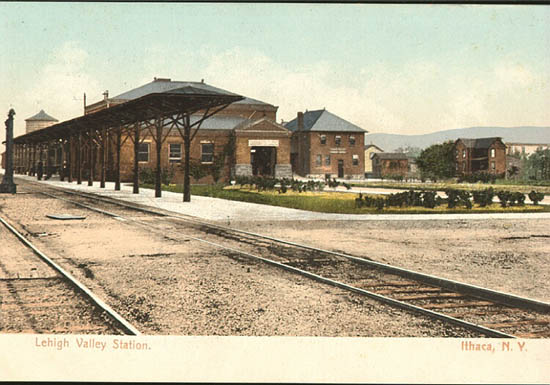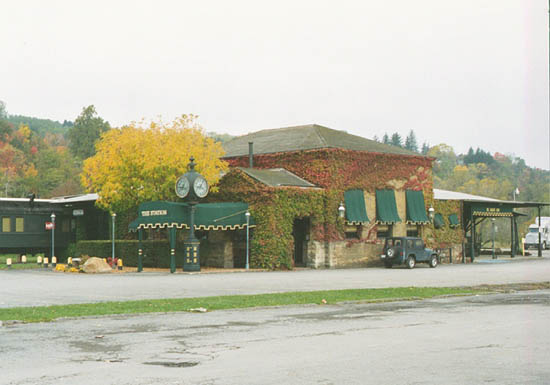Ithaca, New York
The Lehigh Valley Railroad was among the most colorful of all New
York Stateís many trunk line railways. The Lehigh remains one of
my all time favorite operations, and itís rich history is part of the
fabric of life in Upstate New York.
Ithaca is located in the south central portion of the Finger
Lakes. Situated at the base of Cayuga Lake, Ithaca is the site of two
major institutions of higher learning, Ithaca College and Cornell
University. The city is surrounded on three side by hills, and the Lake
on the fourth. Because of this geography, the Lehigh Valley
constructed a bypass route to expedite freight. The passenger main
however went through the city and during the railroads prime years some
eighteen trains per day utilized the Ithaca branch. Steep grades
westbound often meant double headed steam consists. What a sight
and sound show it must have been to witness a train barking up the grade
to Willow Creek and Trumansburg. Taking a train west out if Ithaca
required plenty of skill on the part of the Valleyís engineers.
In addition to the passenger line west, Ithaca was the end point
for the Auburn & Ithaca branch which went up the east shore of
Cayuga Lake. In Auburn, it connected with another Lehigh branch that ran
northeast from Sayre, Pa. up the Newark Valley through Freeville to
Auburn, and on to the Lake Ontario port of North Fair Haven. Like
many other railroads, the Lehigh Valley was primarily a coal
hauler. Black Diamonds provided more than just a neat name for the
railroadís premier passenger accommodation, but a healthy source of
revenue to the balance sheet. Early on, the Valley became a fast
merchandise expediter. Swift freight trains carried manufactured
goods from the industrial complexes in Niagara Falls and Buffalo east to
the New York harbor ports in New Jersey. Important Canadian connections
in Niagara Falls (Suspension Bridge) contributed large numbers of car
loadings to the busy mainline.

A view from approximately 1910 of
the Ithaca depot. The freight house is at the right.
The Ithaca depot was constructed just over one hundred years ago,
in 1898 by local Ithaca architect A.B. Wood. The yellow pressed
brick station was done in a Colonial Revival motif and has Romanesque
style arches incorporated into it. With a status as an important
passenger station, the railroad furnished the station with a high
quality interior, much of which is still intact today. Ithaca was
so important to the railroad that in addition to the station, it also
had a downtown ticket office at State and Aurora Streets. Several
generations of Cornell students and alumni would recall with pleasure
arriving and departing from the Ithaca depot. In Autumn, football
specials brought in crowds for the games. The presence of Cornell
University also gave the railroad itís trademark "Cornell
red" colors, used extensively in later days on the Valleyís
classic Alco & EMD diesel fleet.
After World War II, the railroad sought to modernize and
streamline itself in the robust but changing economy. The late
1940ís saw the demise of steam, and cutbacks in passenger
service. The railroad would give up itís passenger service
altogether in 1961. By then it was only a shadow of itís former
glory.
The tracks were removed but the depot was spared. Today the
station houses a fine restaurant. One can dine in the former
waiting room. While your meal is being prepared, view the displays of
railroadiana and listen carefully for the ghost train whistles of the
Lehigh Valley railroad.

October 12, 1998. Photo
by Jon Rothenmeyer.